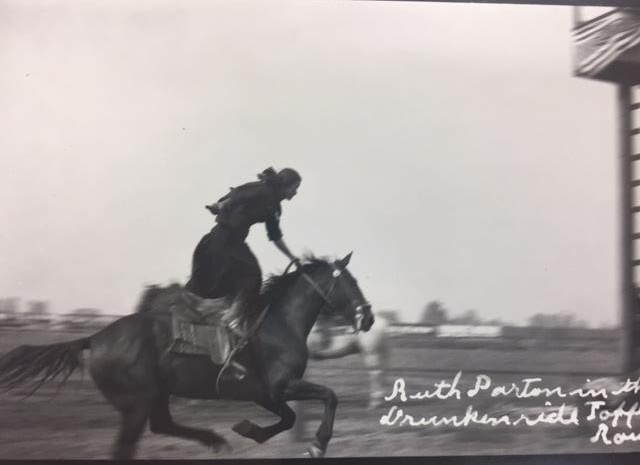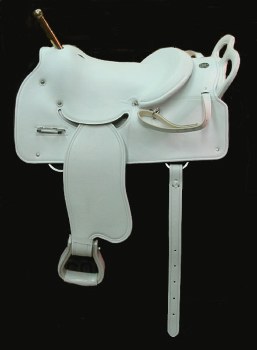Maris, Henry Eston. Ruth Parton in the Drunken Ride. 1914, Washington State University Manuscripts, Archives, and Special Collections, Pullman. Photograph.
The Karen Vold Special. Pikes Peak Saddlery, http://www.pikespeaksaddlery.com/id130.htm.

This image comes from a collection of photographs taken by Henry Eston Maris of the Toppenish Roundup and Rodeo in 1914. This particular picture showcases Ruth Parton astride her horse in the Drunken Ride on a trick riding saddle.
The trick saddle exhibits narrow fenders which are the leather flaps that hold the stirrups. Parton is using the additional stirrups often seen attached to the pommel of most trick riding saddles used today. These extra straps would allow the trick ride to get up, out of the saddle to perform standing tricks on the horse’s back. The cantle on this saddle is very short compared to other western saddle cantles as well as a very shallow seat that is nearly flat from pommel to cantle. Lastly, this saddle has a shorter skirt and is much shorter in length than some of the other saddles seen in the photograph collection as well as those used today.
Trick saddles are very similar to western saddles yet they often look much different in the little details due to how differently they are used. Western saddles often need deep seats, high cantles, and wide horns to help the rider rope, race, or work with cattle. On the other hand, trick riders need saddles with tall but narrow horns, a shallow seat, smaller cantles, and additional straps that enable them to get out of the saddle easier and perform various tricks. These seemingly small changes to a saddle can create a huge difference in not only how it’s used but also how it functions. A rider may desire certain traits in a saddle like a specific horn style or pommel grip size depending on what they want to do with it however, many changes also affect how it works with the horse. Trick riders need a saddle that can spread their weight evenly throughout their horse’s back no matter where they are on the saddle. Most saddles are designed based on the idea that the rider will primarily be sitting or standing in one stirrup to mount. The trick riding saddle is designed so that it sits in the center of the horse and distributes weight whether the rider is vaulting on to it, standing on the pommel, doing tricks off the back or sides, and even spinning around the horn.
